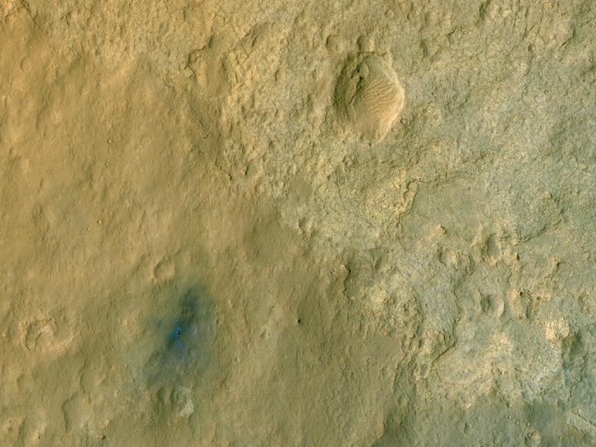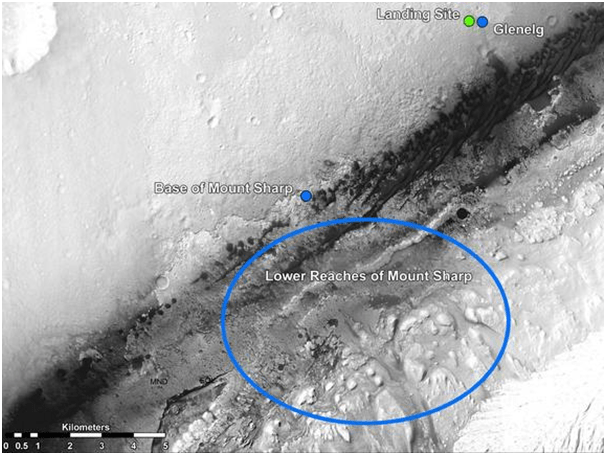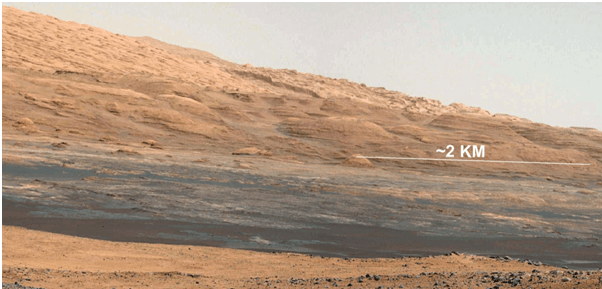Curiosity succesfully landed on Mars over three weeks ago (Earth time), and has since sent us back this HD video of its spectacular plummet – including a not so graceful landing of the jettisoned heat shield:
Now, the rover is on its way to its first region, Glenelg, 400 metres east of its landing spot. Curiosity has a lot to live up to, with its sister Opportunity still exploring, and Spirit having a successful stint for nearly seven years, before communication was lost in March 2010. But what has the inquisitive robot laboratory been up to since it parachuted down onto the red planet?
Since successfully landing in the enormous Gale Crater with all the skill of a feline, Curiosity has been undergoing all the necessary health tests for a two year long mission into the unknown.
The NASA team aren’t taking any risks with such a valuable mission, and are taking things nice and slowly. The only issue that has occurred so far is damage to one of the wind sensors, possibly caused during the landing as dust and stones were whipped about the delicate machinery.

Colour-enhanced view of Curiosity’s landing site, taken from NASA’s Mars Reconnaissance Orbiter. The colour variation emphasises the different rock composition at the landing site, revealed during the Rover’s landing. Source: NASA
Curiosity is equipped with a pretty awesome armoury, a sort of ‘Swiss-army knife’ array of instruments including a percussive drill and soil-scooping gear held on a 2.1 metre long, 30 kilogram robotic arm, to go with instruments such as a mass spectrometer and gas chromatograph on the main torso. Oh, and it’s equipped with 17 cameras too. Four of these are for navigation purposes, and sit on the robot’s ‘head’. The robotic arm has been successfully unpacked and tested by flexing its joints:
This has all been done remotely from NASA, including updating Curiosity’s software package. Over all this inter-planetary distance, the delay for communications is only 14 minutes!
The images the Curiosity is producing are nothing less than breathtaking. This high-resolution colour mosaic shows the geological environment surrounding its landing site, and bears a striking geomorphological resemblance to areas in the south-western United States. Visible structures of interest to geologists include a network of valleys, likely to have been formed by erosion from fluids, and the various sedimentary features at the lower reaches of Mount Sharp. Additionally, some subsurface material has been exposed during the blast produced by the descent rockets. Even more stunning than this image, is this fully interactive panorama, where you can explore the landscape for yourself in exquisite detail. The NASA team have been tweeting on behalf of Curiosity – a great place to get live updates from the mission.

Part of the conversation between target practice rock and one of the engineers at NASA. Poor rock. Source: NASA
Curiosity has tested its laser, coining the hash-tag on Twitter, #PewPew, much to its followers’ collective amusement. This ‘ChemCam’ can shoot its laser up to 23 feet. The rock designated for target practice even had its own Twitter account created, and had a nice conversation with the technicians at NASA. The results of this pilot test have yet to be released, but if the rocks turn out to be in situ (instead of ejecta) they could provide valuable information about the geological history of Mars. The laser works by blasting a tiny area of rock, creating an ionised, glowing plasma, which is then analysed by three spectrometers, similar to analyses conducted in labs around the world today. The results should provide information about the chemical composition of the rock, which is the key to unlocking its geological history.
Our last blog post looked at exactly how the adventurous Rover would go about its crater-hopping duties. NASA uploads steering commands on a daily basis that guide the robot on a step-by-step-basis. The latest preparation (August 22nd), then, has been to check that Curiosity could actually drive. It would be a little frustrating after going all that way if it had to stay rooted to the spot, especially with so much to explore! Taking its first baby steps, Curiosity performed a simple manoeuvre, driving 4.5 metres, rotating 120 degrees and reversing 2.5 metres to orientate itself ready for its first target region. As well as this, Curiosity has an autonomous drive function for a bit of navigational freedom, but this is yet to be tested by the NASA team.

Image taken from NASA’s Mars Reconnaissance Orbiter showing the landing site, Glenelg, and the target zone for exploration around the lower reaches of the vast Mount Sharp, a 5 kilometre thick stratified sequence. Credit: NASA/JPL-CalTech/University of Arizona.
Glenelg is thought to be quite geologically diverse, so makes a great training ground for the mobile science lab. Strata near the base of Mount Sharp are distinctly tilted, further evidence for tectonic movements on Mars. Orbital imagery also suggests that these layers contain clays and other hydrated minerals, all indicative of a fluid water phase on Mars in the past. Geologists have already speculated that there are structures visible in the photographs sent back (see below), such as unconformities and cross-bedding. It will be some time, however, until detailed analysis of the stratigraphic, tectonic, and geochemical structures are completed.
Even though it will take Curiosity about a month to rock and roll to Glenelg, one thing is for sure: the hunt for evidence of extra-terrestrial microbial life is on.


Reblogged this on Green tea and Velociraptors and commented:
Post for the Geological Society of London’s blog covering the antics of that li’l robot so far, and geological prospects!
This is stupid, there is clearly no evidence for the existence of the planet “Mars”. If there was, the Bible would say so, but it doesn’t – check Genesis! There’s the Earth, Moon & the Stars – but no Mars!!! So how can you land there? You can’t! That’s how.
And what’s all this stuff about life beyond the Earth? The Garden of Eden was on Earth – Check the Bible. There are no aliens, big or small because God only made life on Earth! Check your facts atheist – clearly Satan has corrupted your brain but deep inside you know that there is only God!
Gee-whiz, science doesn’t prove anything, it’s all theory but not fact! You people all rely on your “facts”, well I’ll tell you something, there is only one true set of facts, and that is the Bible, written by God himself and passed down to Jesus. Now move along and stop spreading lies about planets that you can’t prove exist – and if you can, why haven’t people been there hmm? Mars isn’t a real place!
Jerry Coyne will be appalled, shocked I tell you, about your terrible treatment of the Essex Lion. And I’m going to tell him!
Pingback: Curiosity continues to rock on Mars | Green tea and Velociraptors
Pingback: Geological Society of London blog